.jpg)
.jpg)
Switchback Travel
.jpg)
.jpg)
Switchback Travel
Let’s face it: It rains, and sometimes it pours. Thankfully, a good rain jacket can provide a solid layer of defense against the elements. The women’s options here range from $75 to $500 and run the gamut from everyday models with urban styling to breathable jackets for hiking and more. We’ve divided our picks into three categories—daily use, hiking, and performance—but regardless of their end use, all of these rain jackets have what it takes to perform well in a rainstorm: waterproof membranes, seam sealing and DWR coatings, and secure hoods. Below are the best women's rain jackets of 2024. For more information, see our comparison table and buying advice below the picks. We’ve also compiled a list of the best rain jackets, which covers both men’s and women’s styles.
Editor's note: We updated our women’s rain jackets round-up on March 29, 2024, to add the latest REI Co-op Rainier and Outdoor Research Aspire jackets, both of which were recently updated. We also removed the REI XeroDry GTX and Patagonia Storm10 due to limited stock at the time of publishing (keep an eye out for new versions this fall).
 Category: Daily use/hiking
Category: Daily use/hiking
Weight: 12.4 oz.
Waterproofing: 3L H2No Performance Standard
What we like: Affordable 3-layer performance in an everyday jacket.
What we don’t: Heavier than the competition and no waterproof zippers.
The best overall rain jacket balances premium weather protection, versatility (for both everyday use and hiking), and great quality and durability—all at an affordable price point. By all measures, the Patagonia Torrentshell 3L stands out among the crowd. On one hand, the Torrentshell is clearly intended for casual wear with a reasonable $179 price tag, durable 50-denier face fabric, roomy fit, and feature set that doesn’t skimp on convenience. On the other, it boasts a 3-layer H2No Performance Standard construction, putting its weather protection on par with true performance pieces. And with a recent update, the Torrentshell 3L is now fully PFC-free (including both the waterproof membrane and the DWR finish), highlighting Patagonia's commitment to sustainable manufacturing practices.
The Torrentshell 3L is remarkably versatile, but it’s certainly not the most technical option here. You don’t get hipbelt-compatible pockets or sleek water-resistant zippers, and the 12.4-ounce weight is on the heavy end. Plus, while the fit of the Patagonia is trimmer than full-on casual models such as the REI Co-op Rainier below, it’s noticeably roomier than performance-focused jackets like Arc'teryx's Beta LT. But for $179, you’d be hard-pressed to find a more protective and breathable jacket that looks this good. Keep in mind the Torrentshell 3L is available in a parka-length version, too ($249), which offers even more coverage and has great urban styling... Read in-depth review
See the Patagonia Torrentshell 3L
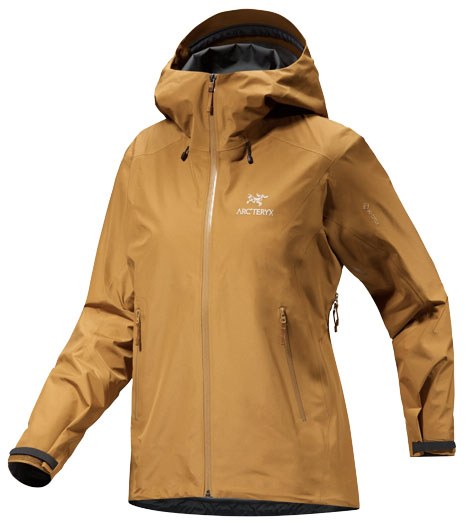 Category: Performance/hiking
Category: Performance/hiking
Weight: 12.3 oz.
Waterproofing: 3L Gore-Tex
What we like: Premium hardshell protection and features in a lightweight package.
What we don’t: One of the priciest rain jackets on our list at $450.
Based in British Columbia’s rain-soaked coastal mountains, it should come as no surprise that Arc’teryx specializes in waterproof clothing. Their Beta LT is a high-end offering that blurs the lines between the hardshell and rain jacket categories. Featuring a high-end, 3-layer Gore-Tex construction, the Beta LT delivers trustworthy all-around protection for 4-season backcountry exploration. But with a trimmed-down and relatively thin 40-denier face fabric, small packed size, and useful features like pit zips, it can pull double duty for casual hiking, travel, and even around town (especially in a rainy area like the Pacific Northwest). And as we’ve come to expect from the brand, all of the Beta’s details are nicely sorted, with premium seam taping and a fit that is reasonably trim but roomy enough for layering.
What’s not to like with the Beta LT? Most significantly, the price: At $450, it’s one of the most expensive rain jackets here (second to the Beta Coat below) and arguably overkill for many summer backpacking scenarios. By opting for the more casual Torrentshell 3L above, you save around $270 with only small compromises in protection and long-term durability. But the Beta does undeniably offer a number of performance-related benefits and useful extras like a water-resistant front zip and a helmet-compatible hood. For those who get out a lot and aren’t wanting to spring for a full-on Gore-Tex Pro hardshell, it's a nice middle ground. Finally, casual users will want to check out Arc’teryx’s Beta Jacket ($400), which checks in at just 10.6 ounces and features a 3-layer Gore-Tex with a C-Knit backer, low-profile hood, and more relaxed fit.
See the Arc'teryx Beta LT
 Category: Daily use/hiking
Category: Daily use/hiking
Weight: 9.9 oz.
Waterproofing: 2.5L HydroWall
What we like: A great value and also available in a parka-style design.
What we don’t: REI’s HydroWall membrane is no match for Gore-Tex.
Almost every manufacturer here offers an entry-level rain jacket that clocks in around the $100 price point, and REI Co-op’s Rainier is the best-executed of the bunch. This is a great value for penny pinchers who don’t want to sacrifice too much performance, with ample moisture protection and wind resistance via a 2.5-layer HydroWall membrane and nylon ripstop shell, pit zips to keep air flowing, and nice touches like a packable build and fleece-like liner at the collar. It’s certainly not the lightest or most streamlined jacket here, but for just $100 (and less if you hold out for one of REI’s popular sales), the Rainier is truly a steal.
That said, there are a number of shortcomings that come baked into such a budget-oriented design. Most significantly, REI’s in-house membrane is no match for Gore-Tex, meaning that the Rainier suffers in terms of breathability and is quicker to wet out in sustained rainfall. What’s more, most women will find the Rainier to be rather roomy (and even boxy), while premium jackets from brands like Arc’teryx and Patagonia feature more tailored patterning that’s both more flattering and better for mobility. Finally, it’s not the cheapest jacket in REI’s lineup: The Trailmade is just $70, although it makes noteworthy compromises in protection and material quality. In the end, for light showers and quick errands in a downpour, the Rainier is our favorite budget pick. For a step up in performance, REI’s new Flash Stretch is less of a value at $169 but comes with upgrades like integrated stretch and a standing collar.
See the REI Co-op Rainier
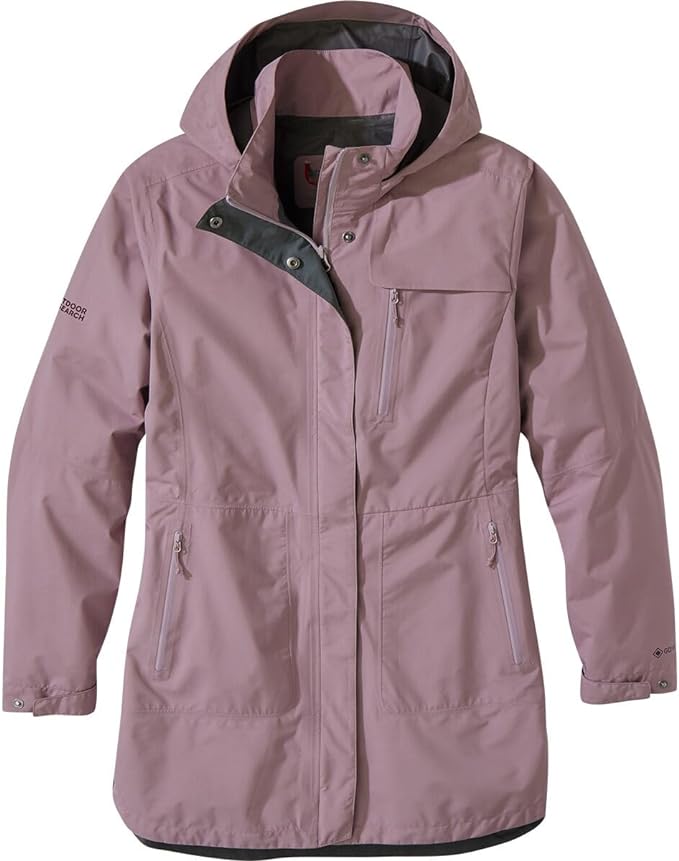 Category: Daily use
Category: Daily use
Weight: 12.7 oz.
Waterproofing: 2.5L Gore-Tex Paclite
What we like: Urban style with few sacrifices in performance.
What we don’t: Not versatile and fairly short for a trench-style jacket.
For those who live in wet climates like Washington’s west side or the coast of Maine, a rain jacket is a wardrobe staple for at least half the year. While some women appreciate the versatility and savings of a one-quiver design like the Torrentshell 3L above, others will find the added coverage and style of a thigh-length jacket to be well worth the investment. Unless we’re counting ounces or need to stay highly mobile, we love the extra protection for walking in the rain, sitting down on wet surfaces, and pairing with clothing like bulky sweaters, blazers, and dresses. And despite their casual intentions, many parka-style jackets don’t sacrifice much in the way of performance, with fully waterproof constructions and high-quality finishes.
With many of the same top-notch performance features as their popular Aspire II jacket below, Outdoor Research’s Aspire Trench is our favorite parka-style raincoat of the season. The styling of the Aspire is top-notch, with a trendy mid-thigh cut (36-in. center back length), flattering shape with waist cinch, snap wrist cuffs, and a simple hood and collar. The contoured hem with side snaps is great for sitting without fabric bunching in your lap, and the jacket holds its own in terms of technical features with a premium Gore-Tex Paclite membrane, supple yet durable (50D) face fabric, and 12.7-ounce weight (impressive for the amount of coverage you get). You can save a lot of money with a jacket like the REI Rainier Long Line ($139), but for the best mix of elegance and performance, the OR Aspire Trench gets our vote. And if you’re looking for something a little longer, check out the Kühl Jetstream Trench or The North Face City Breeze below.
See the Outdoor Research Aspire Trench
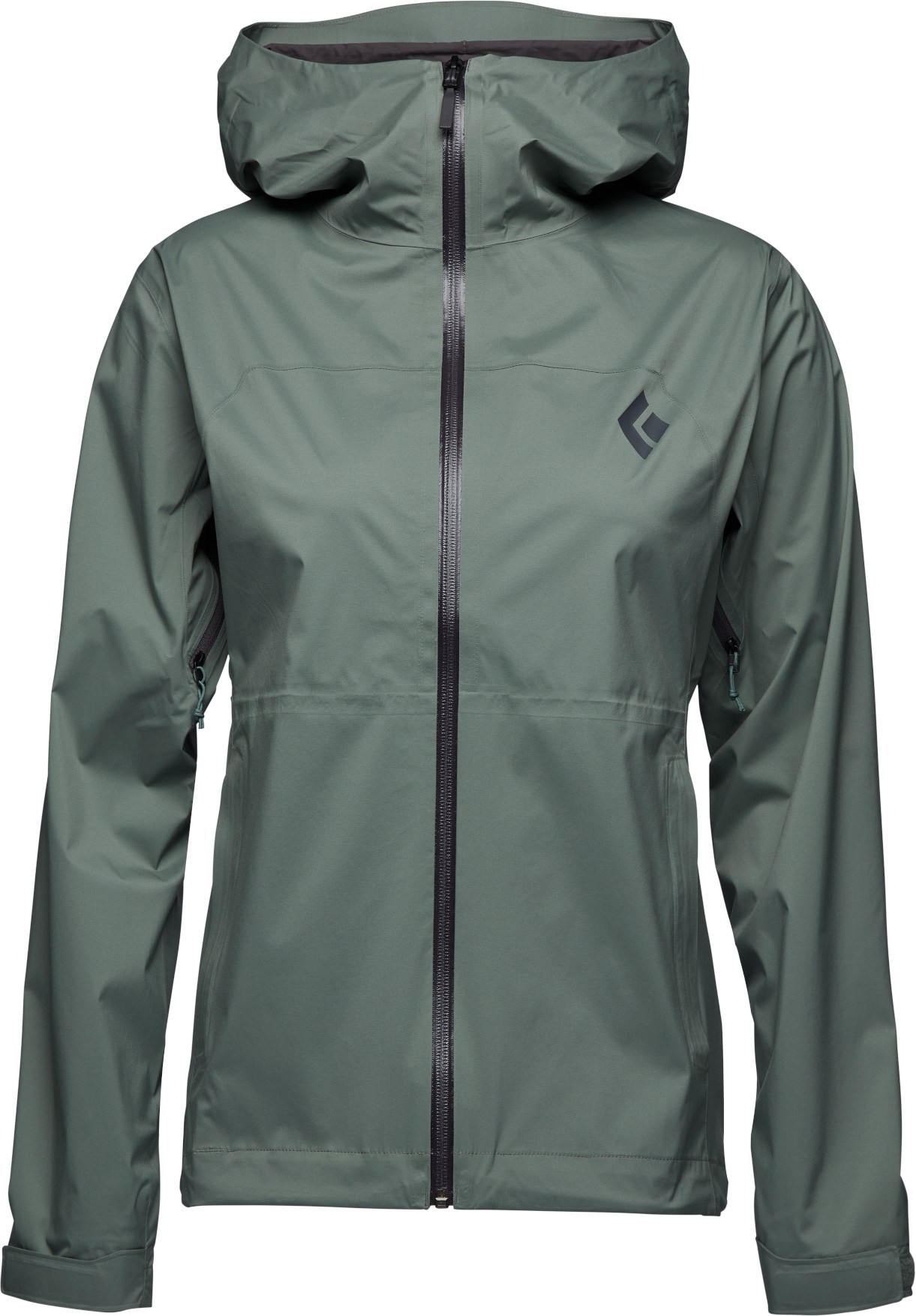 Category: Hiking/daily use
Category: Hiking/daily use
Weight: 9.5 oz.
Waterproofing: 2.5L BD.dry
What we like: Stretchy build offers great comfort and mobility.
What we don’t: BD.dry is not as breathable as Gore-Tex.
Black Diamond’s performance rainwear collection has seen jackets come and go, but the StormLine Stretch continues to be a popular favorite throughout the years. The jacket's hallmark is its flexible 2.5-layer construction that offers a soft next-to-skin feel and more “give” than standard (read: non-stretchy) designs. We’re seeing more stretch-woven waterproof shells hit the market each year and are big fans of this added tech for active pursuits like hiking, backpacking, and fishing. True to its adventure-ready intentions, the StormLine Stretch also comes well-equipped with two hand pockets, a coated front zipper, a helmet-compatible hood, and adjustable cuffs and hem.
Despite its impressive resume in terms of materials and features, the StormLine Stretch is still competitively lightweight (our women’s XS was 8.3 oz.), and the price is right at just $180. In terms of fit, our female tester thought the shell was “spot-on,” with just enough room for layers and slightly long sleeves that offer great coverage and mobility for biking (on the other hand, our male tester found the men’s jacket to be notably large and boxy). Keep in mind that you give up a bit of breathability with BD’s 2.5-layer proprietary membrane, but unlike more streamlined jackets, you do get pit zips for venting. For a small step down in price ($165) and weight (8.5 oz.), we also like Outdoor Research’s new Stratoburst Stretch, although the lack of helmet-compatible hood is limiting for performance use... Read in-depth review
See the Black Diamond StormLine Stretch
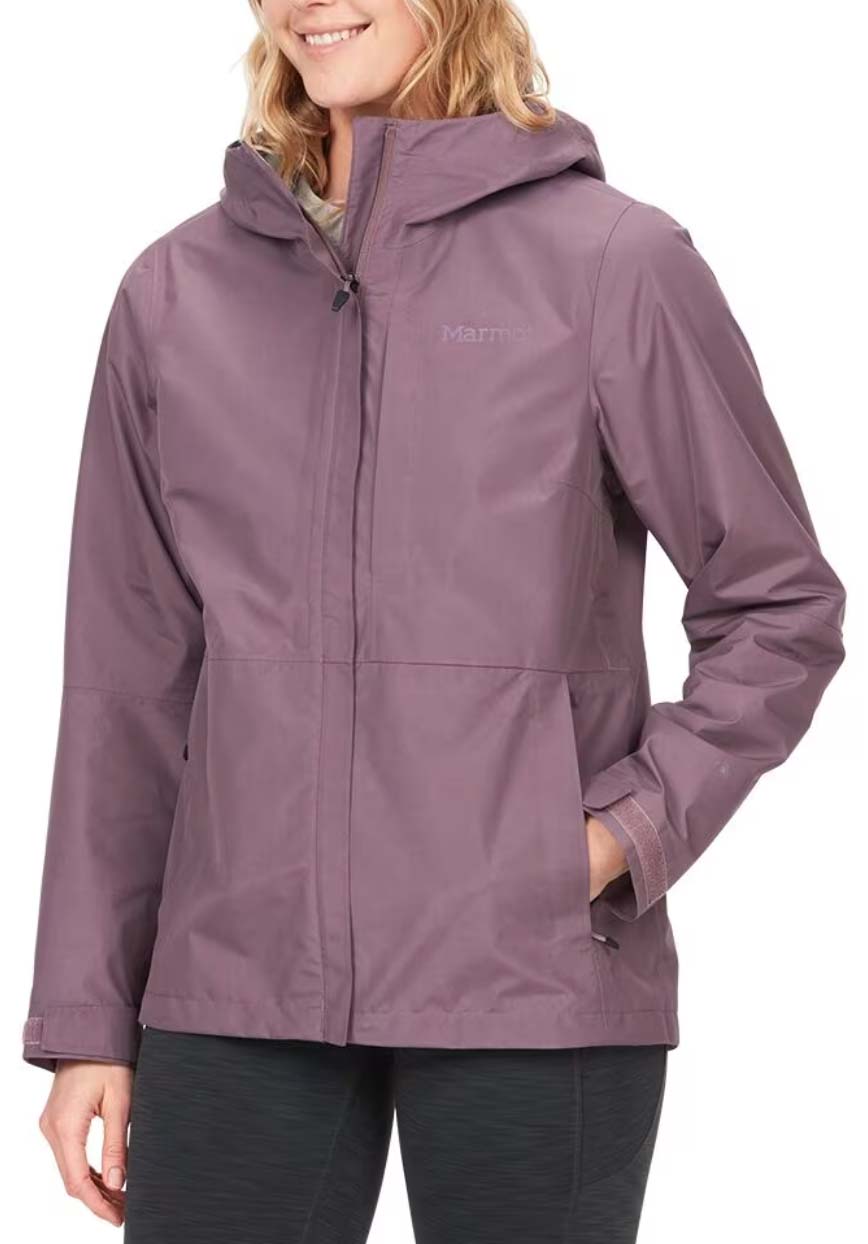 Category: Daily use/hiking
Category: Daily use/hiking
Weight: 13 oz.
Waterproofing: 2.5L Gore-Tex Paclite
What we like: Great value and 100%-recycled face fabric.
What we don’t: Heavy, boxy, and doesn’t dry out quickly.
A versatile rain jacket at a great price, the Marmot Minimalist has hovered near the top of our list for years. The shell has a premium look and feel that immediately sets it apart from entry-level designs, and you get a substantial hood and bill that can withstand heavy rain and wind. On the inside, the lining is less plasticky than most and doesn’t feel as clammy if you start to get warm while walking or hiking. And just about all of the features are reliable and trustworthy, from the burly and confidence-inspiring zippers to the thick cinch cord and easy-to-use toggles at the hem and hood. Finally, it’s worth noting that the Minimalist features a 100%-recycled polyester face fabric and PFC-free DWR, making it a strong contender for those prioritizing a sustainable design.
All that said, the Minimalist has started to show its age, especially among newer jackets like the Patagonia Torrentshell and BD StormLine Stretch above. We would prefer a water-resistant main zipper at this price (you even get one with the $180 StormLine Stretch), and the Minimalist’s fit is much more similar to the Rainier above (read: boxy and loose) than most trim, modern designs. Finally, while the Minimalist got an ounce lighter with the most recent update, it’s still too much jacket for most weight-conscious hikers. But for a tough, outdoor-ready rain shell that wears well every day of the week, the Marmot has proven itself reliable, year after year. For a step up, check out the Marmot Minimalist Pro ($275), which features lighter and more durable Paclite Plus technology along with a water-resistant front zip.
See the Marmot Minimalist
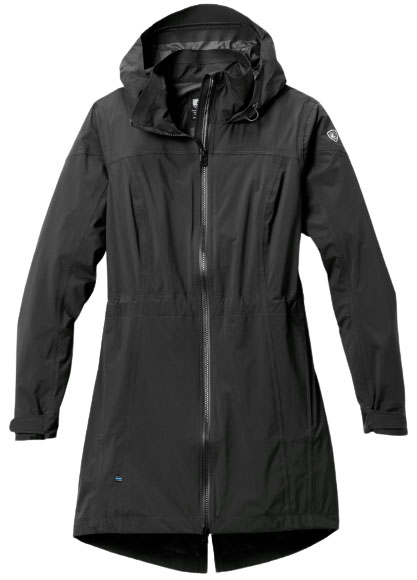 Category: Daily use
Category: Daily use
Weight: 9.6 oz.
Waterproofing: 2.5-layer laminate
What we like: A great value and fun styling.
What we don’t: Kühl’s in-house membrane isn’t super premium.
You can spend upwards of $350 on a parka-length rain jacket, but the KÜHL Jetstream Trench Coat can get the job done for just $219. This jacket checks the boxes for casual users, including high marks for both style and performance. With a 2.5-layer construction, taped seams, and a DWR finish, you get ample protection from steady rain, and features like a two-way zipper and split hem offer great mobility whether you’re sitting, standing, or riding a bike. Kühl also nailed the fashion part of the formula with the Jetstream, which features an elegant drop-tail hem, cinchable waist, and 34-inch length that falls just above the knee.
What do you give up with the low-priced Jetstream Trench Coat? Most notably, the Kühl can’t match jackets like the Patagonia Torrentshell Rain Parka and Arc’teryx Beta Coat (below) in terms of premium finishes, and its materials fall short with a generic 2.5-layer membrane. This translates to compromised weather protection and breathability, although most casual users will find the Jetstream to be fully sufficient for running errands or commuting in the rain. Finally, we appreciate the ability to tailor the waist cinch, which means the Kühl should accommodate a variety of body shapes. All told, the high-value Jetstream offers a great combination of both style and protection for daily use.
See the Kühl Jetstream Trench
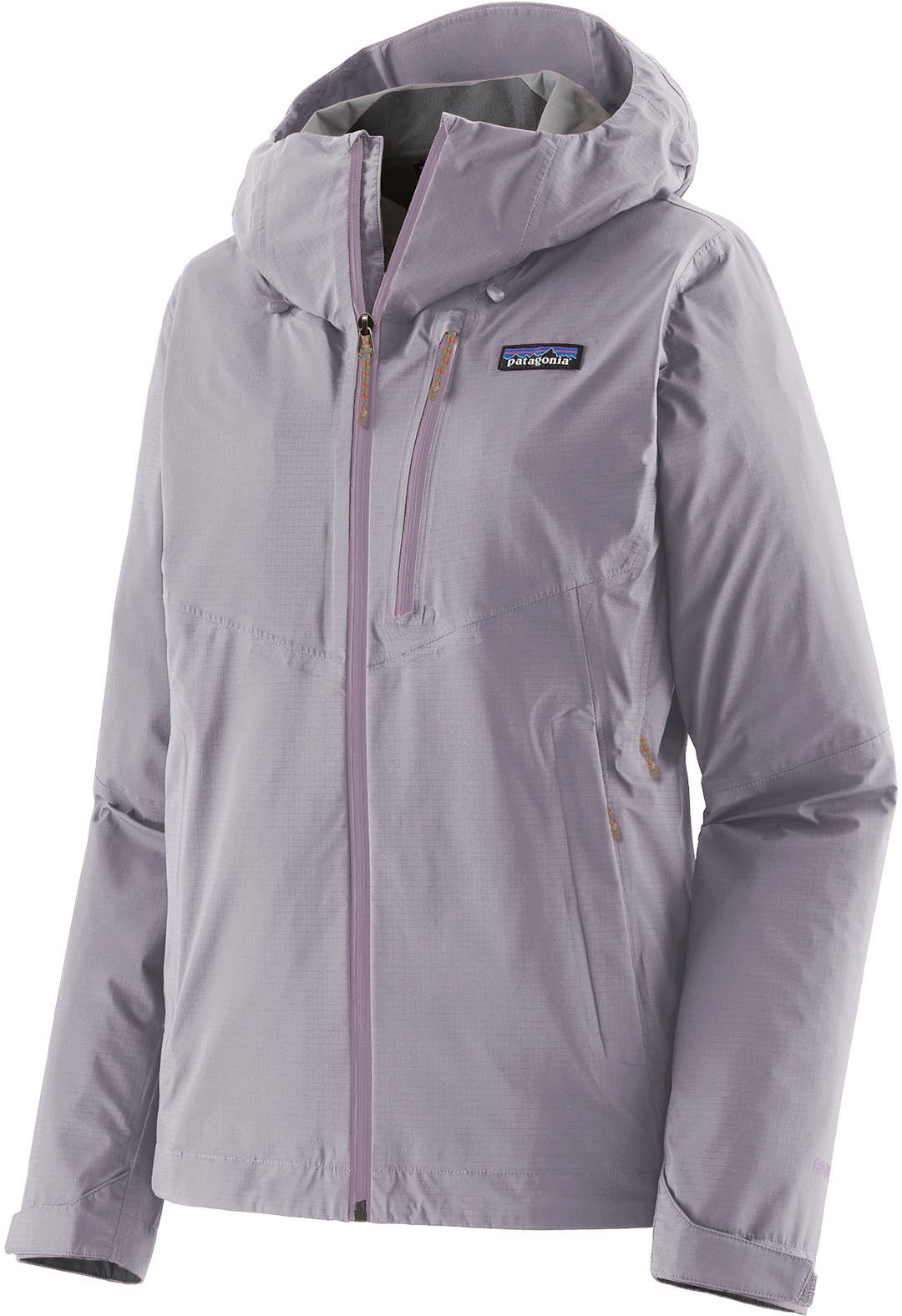 Category: Hiking
Category: Hiking
Weight: 12.6 oz.
Waterproofing: 3L H2No Performance Standard
What we like: Patagonia’s purpose-built jacket for hikers and backpackers.
What we don’t: $100 pricier than the Torrentshell.
Patagonia’s Torrentshell gets our top spot for its mix of premium materials, everyday versatility, and price, but it falls short for performance use. Hikers and backpackers will want to take a look at the Granite Crest here, which offers a more technical feature set, including hipbelt and harness-compatible pockets, a chest pocket, and watertight zippers. What’s more, its thinner 30-denier ripstop nylon face moves and breathes better than the Torrentshell’s 50-denier shell, and pit zips help to dump heat during muggy hikes (the Torrentshell also has pit zips). All told, the Granite Crest is a low-bulk and high-function alternative to our top pick, and Patagonia’s most purpose-built rain jacket for the trails.
Like the Torrentshell, the Granite Crest stays true to Patagonia’s environmental values, with 100%-recycled nylon (made from discarded fishing nets) and a fully PFC-free design. It’s also available in a range of colorways (six at the time of publishing) and sizes (XXS to XXL). The biggest downside is price: At $279, the Granite Crest is a full $100 more than the Torrentshell, and despite its backcountry-ready personality actually checks in a tad heavier (12.6 vs. 12.4 oz.). But hikers will love the trail-ready storage, and the thinner shell will be a welcome substitute on mild days or during heart-pumping climbs. For a more streamlined alternative that splits the difference between the Torrentshell and Granite Crest, check out Patagonia’s new Boulder Fork... Read in-depth review
See the Patagonia Granite Crest
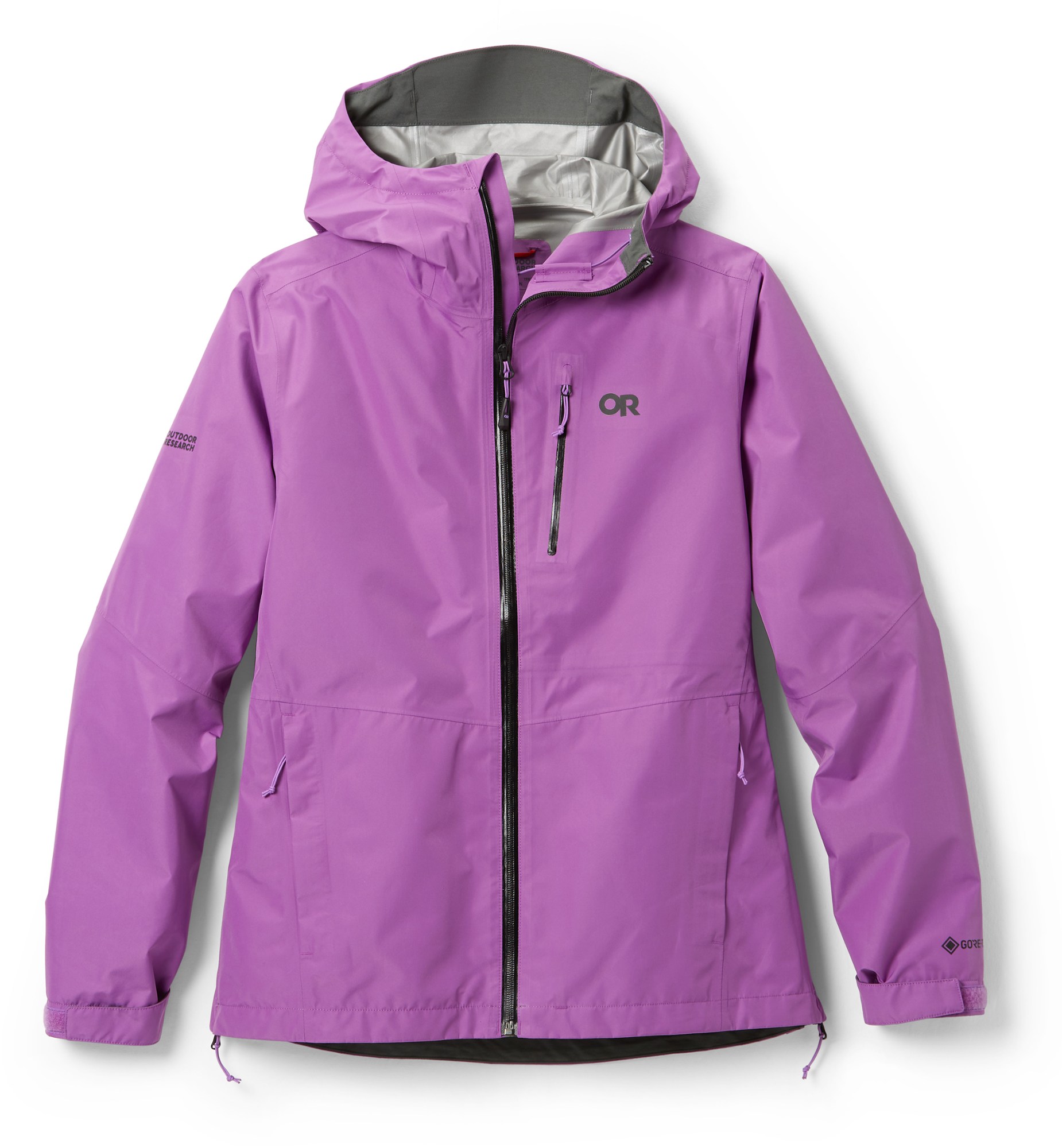 Category: Hiking/performance
Category: Hiking/performance
Weight: 11.7 oz.
Waterproofing: 2L Gore-Tex Paclite
What we like: Performance-oriented fit and features at a decent price.
What we don’t: Not everyone will love the TorsoFlo vents and boxy fit.
Outdoor Research’s Aspire Trench above is our favorite thigh-length design and great for around-town use, but the standard Aspire is much more of an all-rounder. Recently updated, the latest “II” retains most of what we loved about past versions, including a trustworthy 2-layer Gore-Tex Paclite construction and slight performance slant. Compared to more casual alternatives like the Marmot Minimalist above (which also uses Gore-Tex Paclite), the OR is both lighter and sleeker, with quality additions like a water-resistant front zipper. The truly unique feature is the jacket’s TorsoFlo system, which comprises full-length side zips that extend the pit zips all the way to the bottom hem. When fully unzipped, this creates a poncho-like opening that can ride over your backpack hipbelt, allowing unencumbered ventilation while still retaining full waterproof coverage.
The Aspire was recently updated with modernized colorways, a stronger sustainability focus, and availability in a larger range of sizes (from XS to 4X). All told, it slides into a nice middle ground in terms of cost and design, offering a much more performance-oriented feature set than budget models without the premium price point of jackets like the Beta LT. It’s true that 2-layer Paclite construction is still slipperier and more prone to clamminess than a 3-layer shell, and we found the fit of the latest version to be decidedly boxy (especially around the midsection). But apart from these relatively minor complaints and the polarizing nature of the TorsoFlo vents, the Aspire II is a great value and an excellent quiver-of-one jacket for backpacking, spring skiing, and daily use. Outdoor Research also makes the Aspire Super Stretch ($300), which adds a stretchy Gore-Tex panel at the back for greater mobility... Read in-depth review
See the Outdoor Research Aspire II
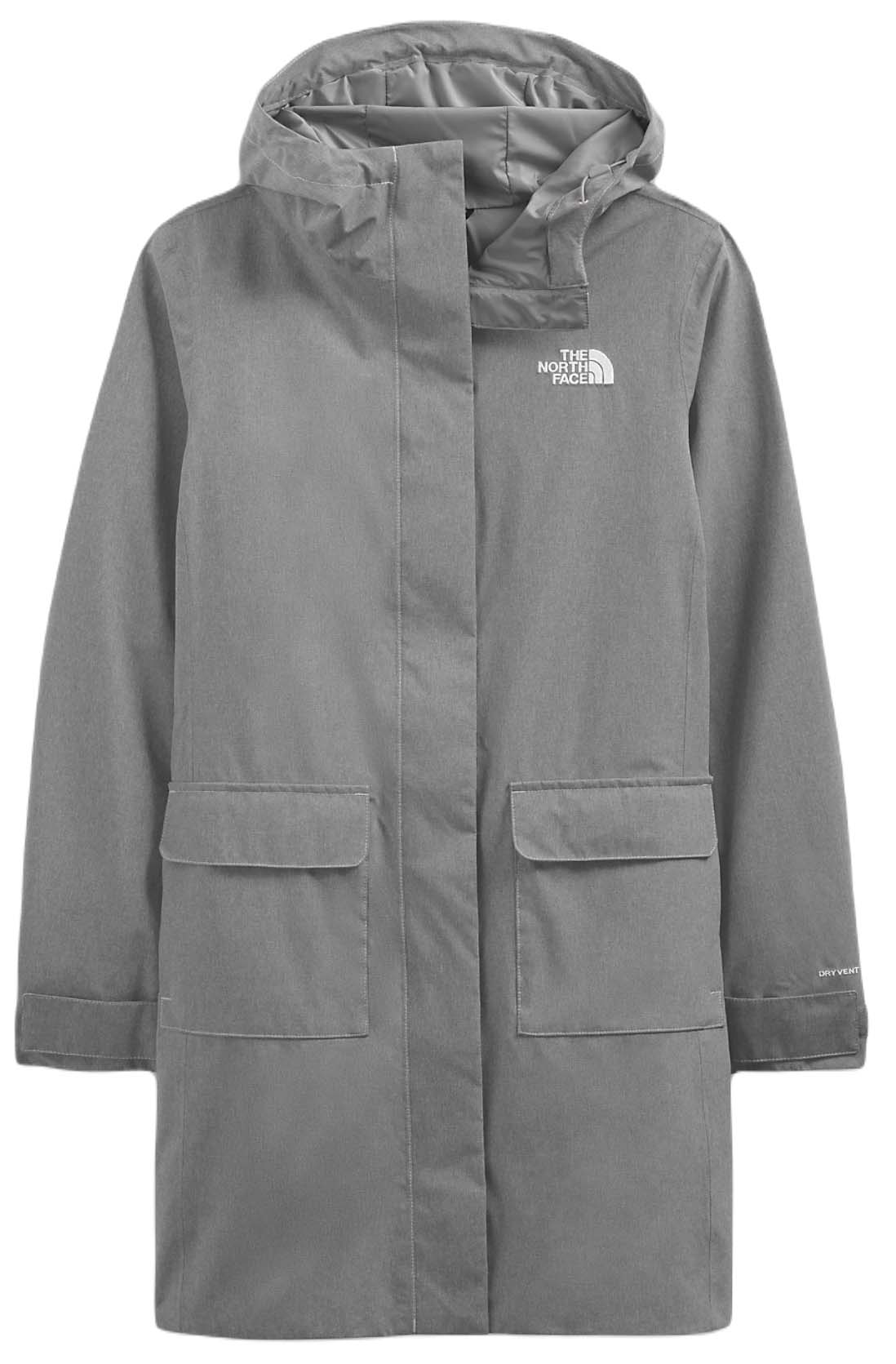 Category: Daily use
Category: Daily use
Weight: 10.9 oz.
Waterproofing: 2L DryVent
What we like: An inexpensive yet stylish parka for casual use.
What we don’t: Poor breathability and too warm for mild climates.
If the OR Aspire Trench and Kühl Jetstream above caught your eye, it’s also worth checking out The North Face’s City Breeze Rain Parka II. This is a much-loved parka-length design from a respected outdoor brand, merging performance and protection with everyday appeal. The City Breeze features a similar cut (35.75 in. vs. the Aspire Trench's 36 in. and the Jetstream’s 35 in.), along with classic touches like front patch pockets with flap closures, elastic at the back waist, and an oversized placket covering the front zip. It all adds up to a super stylish and decidedly casual design for rainy days around town.
The City Breeze Rain Parka II is a steal at just $180 (and even less on Amazon at the time of publishing), but it’s important to know what you give up with such a budget design. In this case, the primary sacrifice is breathability: The 2-layer DryVent membrane can’t compete with higher-end offerings from Gore-Tex, and the jacket’s hanging polyester liner further impedes airflow away from your body. Further, the jacket will be much more prone to wetting out in consistent rain than some of the more premium designs here. As a result, we wouldn’t recommend the City Breeze for anything more than casual walks around the block, nor is it a great choice for rainy days in warmer climates like Hawaii or the south. But for wet and cold commutes, errands, and dog walks, it’s all the protection most people need in a stylish, easy-going design.
See the Women's The North Face City Breeze II
 Category: Performance
Category: Performance
Weight: 7.8 oz.
Waterproofing: 2L Gore-Tex Paclite Plus
What we like: A streamlined shell that doesn’t sacrifice protection or mobility.
What we don’t: Pricey and not the most breathable design.
Norrøna flies a little under the radar in the U.S., but make no mistake: This Norway-based brand has a competitive collection of high-end shells built for rugged backcountry use. Their Falketind Gore-Tex Paclite Jacket is a case in point and was quick to impress on a backpacking trip in Southern Patagonia. Dubbed the brand’s lightest and most packable waterproof jacket, the Falketind offers trustworthy protection and an alpine-ready feature set in a diminutive, 7.8-ounce package. True to its minimalist intentions, the Falketind uses a thin but tough 20-denier shell, keeps storage to a minimum with just one chest pocket, and boasts simple adjustments at the hood, hem, and cuffs. All told, we’ve found the design to be extremely practical for weight-conscious pursuits that still warrant dependable weather protection.
The Falketind costs a whopping $349, which is unquestionably steep—especially for a 2-layer rain jacket. As expected, breathability isn’t a strong suit, making the Falketind a poor choice for high-output activities. Norrøna did include a mesh-backed vent at the chest, but standard pit zips are far more effective at dumping excess heat. Still, there’s a lot to love about the design—especially if you avoid working up a sweat. In fact, we found ourselves reaching for the Falketind over Patagonia’s similarly light Storm10 (currently unavailable but returning this fall) while alpine climbing in Patagonia due to its longer and harness-friendly cut, larger chest pocket, and boost in comfort and mobility (the Storm10’s 3-layer design was a little stiffer by comparison)... Read in-depth review
See the Norrøna Falketind Gore-Tex Paclite
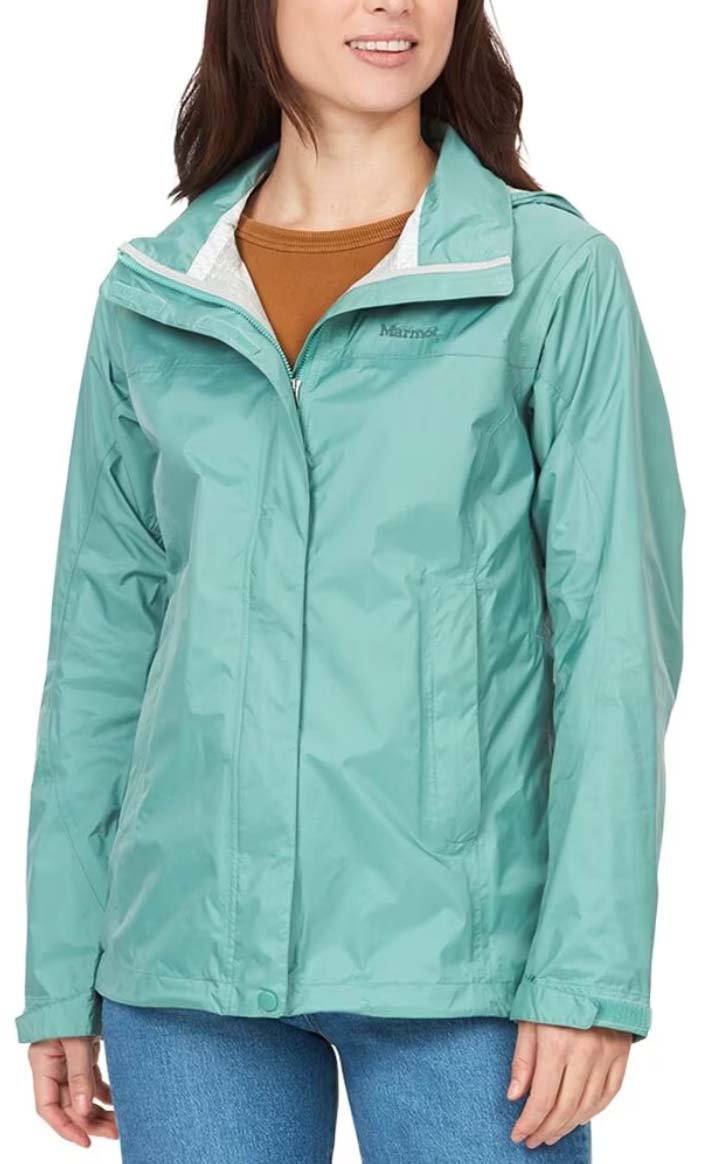 Category: Daily use/hiking
Category: Daily use/hiking
Weight: 9 oz.
Waterproofing: 2.5L NanoPro
What we like: Great price for a solid all-around design; wide range of colors and sizes.
What we don’t: Few performance features and delamination issues are common.
Like REI Co-op, Marmot is known for offering solid quality and performance at reasonable prices. Slotting in as their top entry-level design, the PreCip is hugely popular among hikers, backpackers, and everyday wearers. The formula is simple but practical, including a 2.5-layer construction that can handle light to moderate moisture, full seam taping, and a competitive weight. Unlike many other budget-friendly designs, the Marmot also includes technical features like pit zips, a stuff pocket, and an adjustable hood. Finally, the aptly named PreCip Eco features a 100%-recycled nylon shell and PFC-free DWR finish—a nice nod to Marmot’s ongoing sustainability focus. The $120 price tag is the cherry on top.
Where does the PreCip Eco fall short of the also-budget-friendly REI Rainier above? The two jackets share a good number of features, including similar hood designs, pocket layouts, and even smaller touches like mesh-lined pockets and Velcro covering the center zipper. We give the edge to the REI for its more substantial face fabric and fleece-like collar lining in a $20-cheaper package, but it’s a close call between the two, and many hikers will prefer the Marmot’s lighter and quick-drying build. Again, keep in mind that you get what you pay for with these budget designs—those prioritizing features like breathability, durability, and fit will need to spend up. But for an affordable daily driver that’s proven itself time and time again, it’s hard to go wrong with the PreCip Eco.
See the Marmot PreCip Eco
 Category: Daily use
Category: Daily use
Weight: 11.3 oz.
Waterproofing: 3L Gore-Tex
What we like: Unique mix of technical performance and features in a thigh-length shell.
What we don’t: Expensive; unflattering fit at the mid section.
We can always count on Arc’teryx for top-notch rain gear, and their urban-inspired jackets are no exception. The Beta Coat here merges foul-weather-ready 3-layer Gore-Tex waterproofing with a stylish parka-length design, giving you the utmost in protection for rain-soaked days close to home. Unsurprisingly, the finishes are impeccable, including Arc’teryx’s premium StormHood, watertight zippers, and articulated patterning for great mobility and fit. And with a tricot backer (Gore’s C-Knit), the Beta Coat is soft next to skin and surprisingly easy-wearing, especially compared to the more plastic-y feel of many rain shells.
Like many Arc’teryx products, the Beta Coat is no small investment at $500. And while it’s hard to knock the premium feel of 3-layer Gore-Tex, it’s decidedly overkill for most casual uses, and you can save a lot of money by going with a 2- or 2.5-layer design like the Aspire Trench, Jetstream, or City Breeze above. What's more, with no taper or cinch at the waist, the Beta Coat sits somewhere in between a casual and backcountry piece—some women might like the more performance-y look in the city, but it’s certainly not for everyone. But for uncompromised protection in a thigh-length design, the Arc’teryx is a standout.
See the Arc'teryx Beta Coat
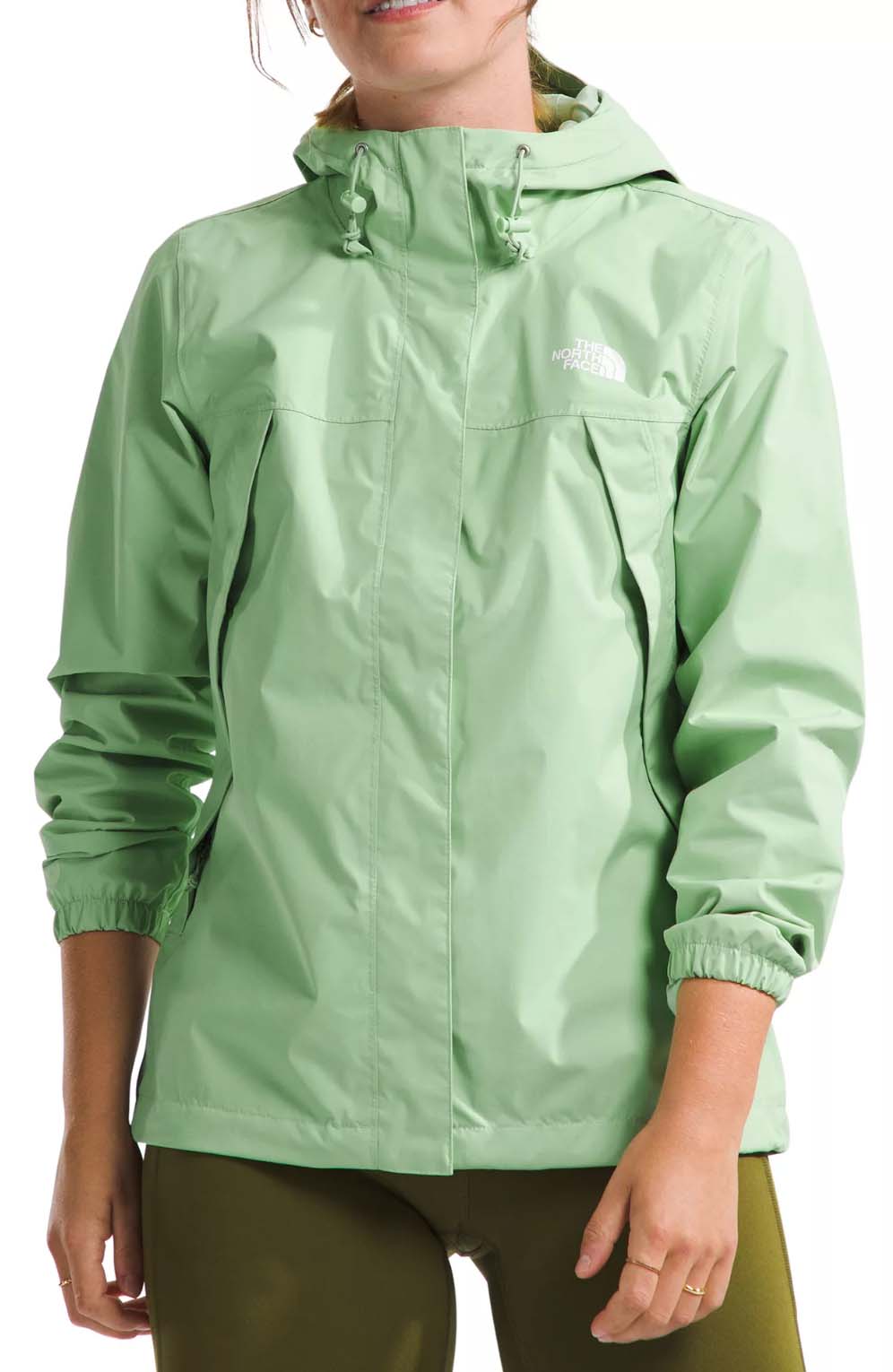 Category: Daily use
Category: Daily use
Weight: 13 oz.
Waterproofing: 2L DryVent
What we like: A modernized take on TNF’s Mountain Light jacket for just $110.
What we don’t: Hanging liner adds bulk and feels cheap.
If pinching pennies is your top priority, The North Face’s Antora is well deserving of a closer look. But the jacket has more going for it than just savings: The Antora is 100% recycled and styled after The North Face’s iconic Mountain Light jacket, with slanted handwarmer pockets and a bold two-tone theme (solid versions are also available). It’s worth celebrating this kind of creativity at its $110 price point. And the Antora is decently durable too, with a 70-denier face fabric that will hold up to a lot of wear and tear.
Compared to the 2.5-layer Marmot PreCip Eco and REI Rainier above, the 2-layer Antora uses a hanging (rather than attached) liner, which results in increased bulk and a cheaper overall feel. It also has our least favorite hood design among the competition, with less coverage at the top of the head and a flimsy bill. But it’s hard to be too demanding of a $110 rain jacket, and what the Antora lacks in performance it makes up for with a dose of retro style and modern sustainability. And for a more breathable option from The North Face (complete with a 2.5L membrane and pit zips), check out the hiking-oriented Alta Vista Jacket.
See the Women's The North Face Antora
 Category: Hiking
Category: Hiking
Weight: 6.3 oz.
Waterproofing: 2.5L Pertex Shield Diamond Fuse
What we like: A minimalist shell that doesn’t compromise much on durability or weather protection.
What we don’t: Very few features and the inside can get very clammy.
At a scant 6.3 ounces, the Helium Rain is the lightest jacket here, geared toward performance athletes whose main objective is to move fast and light. As expected, the design is also highly packable: the Helium Rain stuffs into its hand pocket—great for hanging from a harness—and easily disappears into a corner of your pack when not in use. We’ve tested various iterations of this jacket over the years and have been impressed with how well the Pertex Shield membrane and water-resistant main zipper keep the elements at bay. All in all, the combination of protection and minimalism make the Helium Rain an attractive option as an emergency layer for weight-conscious hikers and backpackers, climbers, mountain bikers, and more.
Outdoor Research uses Pertex Shield with Diamond Fuse technology, which adds significant tear-resistance to the Helium Rain's thin, 30-denier shell. But the jacket's streamlined nature still has its fair share of downsides, namely in the form of features and breathability. With a decidedly "less is more" mentality, the barebones design includes a single-pull hood adjustment and simple elastic cuffs, and the lack of pit zips or vents and 2.5-layer construction mean the Helium Rain can get clammy in a hurry. Notably, the most recent update swaps the chest pocket for two hand pockets (the men’s version sticks to the single-pocket layout), which is either good news or bad news, depending on the user. Given these drawbacks, we’ll stick with a more traditional rain jacket like the Black Diamond StormLine or OR Aspire II above when rain is in the forecast, but the feathery OR has its place as a dedicated just-in-case layer.
See the Outdoor Research Helium Rain
 Category: Performance/hiking
Category: Performance/hiking
Weight: 13 oz.
Waterproofing: 3L Proflex
What we like: A soft, stretchy, and breathable rain jacket for light precip.
What we don’t: Stretchy shell compromises waterproofing.
If you’ve just about had enough with clammy rain jackets or crinkly shells, it’s worth checking out Rab’s Kinetic Alpine 2.0. This is one of the softest and most supple rain jackets we’ve ever worn: The thin (20D) stretch-knit Proflex fabric offers the feel of a softshell (unlike other rain jackets, you can wear this one next-to-skin) and is highly breathable, too. And with a healthy amount of give, it moves as you do, without any of the rigidity common to waterproof shells. Tack on hip belt-compatible hand pockets, an interior chest pocket, an adjustable helmet-compatible hood, and a two-way front zip, and the Kinetic Alpine 2.0 is ready-made for activities like hiking and climbing.
Throughout our testing, the Kinetic Alpine 2.0 performed excellently in light rain and offered a serious barrier against wind, but it showed its weaknesses in sustained wet weather. During a heavy downpour, the stretch-knit face fabric (by nature, more porous than non-stretchy nylon) began to absorb water, forming wet spots on our midlayer underneath. It’s also worth noting that the jacket does not have pit zips (that said, most softshells don’t), and is very trim-fitting—if you plan on layering anything substantial underneath, we recommend sizing up. All told, the Kinetic Alpine 2.0 isn’t as reliable as most of the standard rain jackets here, but if the added comfort and breathability appeals to you, it’s certainly an intriguing option and will get the job done in light moisture. For a step down in price, we also like Rab’s Downpour collection, which lacks the technical feature set and fabrics of the Kinetic Alpine but still checks the boxes for hiking and daily use... Read in-depth review
See the Rab Kinetic Alpine 2.0
 Category: Hiking/daily use
Category: Hiking/daily use
Weight: 14 oz.
Waterproofing: 2L Omni-Tech
What we like: Low price and lots of color options.
What we don’t: Cheap construction has a plasticky feel.
The final women’s rain jacket to make our list this year is Columbia’s Arcadia II, which goes head-to-head with the REI Rainier and Marmot PreCip Eco above as a leading budget design. While it can't hold a candle to the more performance-focused options on our list, the full seam sealing and trustworthy construction make the Arcadia a viable choice for everyday wear or as a backup when conditions are mostly favorable. You also get several features that are typically omitted at this price point, including Velcro cuff adjustments, zippered hand pockets, an adjustable hood, and a stuff pocket. It’s also available in a wide assortment of colorways and sizes, including plus sizes up to 3X.
How does the Arcadia II compare with designs like the REI Co-op Rainier above? With the Columbia’s even cheaper construction, you get 2-layer waterproofing rather than the REI’s 2.5 layers, which translates to more bulk and less breathability and durability. Further, while the Rainier has a clean interior that slides smoothly over layers, the Arcadia’s hanging mesh liner has a distinctly budget feel and is more prone to snagging. But we wouldn’t recommend either jacket for heavy, sustained rain, and it’s hard to argue with the Columbia’s price.
See the Columbia Arcadia II
| Jacket | Price | Category | Weight | Waterproof | Denier | Pit Zips |
|---|---|---|---|---|---|---|
| Patagonia Torrentshell 3L | $179 | Daily use/hiking | 12.4 oz. | 3L H2No | 50D | Yes |
| Arc'teryx Beta LT | $450 | Performance/hiking | 12.3 oz. | 3L Gore-Tex | 40D | Yes |
| REI Co-op Rainier | $100 | Daily use/hiking | 9.9 oz. | 2.5L HydroWall | Unavail. | Yes |
| Outdoor Research Aspire Trench | $249 | Daily use | 12.7 oz. | 2.5L Gore-Tex | 50D | No |
| Black Diamond StormLine | $180 | Hiking/daily use | 9.5 oz. | 2.5L BD.dry | Unavail. | Yes |
| Marmot Minimalist | $220 | Daily use/hiking | 13 oz. | 2.5L Gore-Tex | Unavail. | Yes |
| Kühl Jetstream Trench | $219 | Daily use | 9.6 oz. | 2.5L laminate | Unavail. | No |
| Patagonia Granite Crest | $279 | Hiking | 12.6 oz. | 3L H2No | 30D | Yes |
| Outdoor Research Aspire II | $225 | Hiking/performance | 11.7 oz. | 2L Gore-Tex | 50D | Yes |
| The North Face City Breeze II | $180 | Daily use | 10.9 oz. | 2L DryVent | Unavail. | No |
| Norrøna Falketind GTX Paclite | $349 | Performance | 7.8 oz. | 2L Gore-Tex | 20D | No (chest) |
| Marmot PreCip Eco | $120 | Daily use/hiking | 9 oz. | 2.5L NanoPro | Unavail. | Yes |
| Arc’teryx Beta Coat | $500 | Daily use | 11.3 oz. | 3L Gore-Tex | Unavail. | No |
| The North Face Antora | $110 | Daily use/hiking | 13 oz. | 2L DryVent | 40D | Yes |
| Outdoor Research Helium Rain | $180 | Hiking | 6.3 oz. | 2.5L Pertex Shield | 30D | No |
| Rab Kinetic Alpine 2.0 | $310 | Performance/hiking | 13 oz. | 3L Proflex | 20D | No |
| Columbia Arcadia II | $75 | Hiking/daily use | 14 oz. | 2L Omni-Tech | Unavail. | No |
The Switchback Travel team has tested hundreds of rain jackets over the years, putting them through their paces in rough weather from the Pacific Northwest down to the southern tip of Patagonia. Former senior editor Jenny Abegg originally compiled this guide in 2021, choosing our initial selection of 19 women’s designs. An avid ultrarunner and mountaineer, Jenny has spent countless days in rough and rowdy alpine conditions throughout the Pacific Northwest and beyond. Managing editor Sarah Nelson took over this guide in 2024 and has continued the tradition of using and abusing new additions to the list on backcountry adventures and climbing trips from the Mountain West to her home base in Lake Tahoe.
The list of 17 jackets you see today is a product of our experiences, as well as feedback from our testers and the online hiking community. When we test rain jackets, we evaluate protection by exposing them to inclement weather from light moisture to heavy precipitation. We assess breathability by working up a sweat in the shells, and we keep an eye on how the fabric and smaller components (e.g., drawcords and zippers) hold up over time. As new women’s rain jackets hit the market, we’ll continue to test them and add any standouts to the list above.
.jpg)
If you’re in the market for a rain jacket, chances are you have a pretty good idea of how you want to put it to use. Whether you’re planning for a summer backpacking trip, looking to replace your daily driver, or intrigued by the weight-savings you can get by stepping down from a hardshell, there's a variety of rain jackets well suited for the job. To help you narrow down your choice, we’ve broken down our picks into three separate categories: daily use, hiking, and performance. Most of the rain jackets here fit into more than one category, which can be good news for those looking for a versatile shell.

Daily Use
For those who live in wet regions like the Pacific Northwest or New England, a rain jacket is a critical piece in your daily wardrobe. For day-to-day activities like commuting, running errands, or walking the dog, we look for a casual, relaxed fit that can accommodate layering underneath, along with handy features like hand pockets and Velcro cuff adjustments for sealing out wind. Your exposure to precipitation is bound to be brief, so many—but not all—daily use jackets use cheaper membranes and materials that prioritize affordability over all-out protection, and weight-savings and breathability can suffer here too. On the other hand, we often see thicker and more durable shell fabrics in these designs, great for withstanding day in and day out use. Our favorite daily use jacket is the Patagonia Torrentshell 3L, which crosses over nicely into the hiking as well. We also include parka-length jackets in this category, which offer a great combination of style and protection but don’t parlay as well into backcountry use.
.jpg)
Hiking
Rain jackets designed for hiking are similarly abundant, from budget-friendly options like the Marmot PreCip Eco ($120) all the way up to Arc’teryx’s $450 Beta LT. Compared to more casual and everyday-friendly models, hiking shells are generally lighter and more packable (great for stuffing down and carrying in a pack). Protection is also generally solid, even in sustained rain and heavy winds—especially if you opt for a proven Gore-Tex design or a 3-layer Patagonia shell. Fit can be a bit more streamlined than designs in our daily use category (less fabric means less weight) and breathability is generally good—much better than daily use designs but not totally up to snuff with the performance shells below (most models include pit zips, which helps). For day hikes and the odd overnight trip, these shells are a nice middle ground of price and performance.

Performance
Performance-focused rain jackets are specialized pieces for outdoor use. While not quite up to hardshell standards in terms of protection and breathability, these designs are built to handle rowdy weather and rough use. Common features include tough exteriors, upgraded waterproof membranes that breathe well, and quality hoods that are often helmet-compatible. Comfort and next-to-skin feel are often competitive, too—we’ve found these pieces noticeably softer and less prone to clamming up than those designed for daily use (integrated stretch helps). Notably, performance rain jackets won’t wet out like some of the cheaper options, which makes them the best choice for sustained precip and extended trips. They’re also impressively lightweight, but the tradeoff is streamlined feature sets (sometimes no pit zips) and trim silhouettes that don’t allow much room for layering. Finally, pocket placement can be too high for daily use, but perfect while wearing a climbing harness or backpack. And as expected, price increases with these upgrades—jackets in our performance category are among the most expensive here.
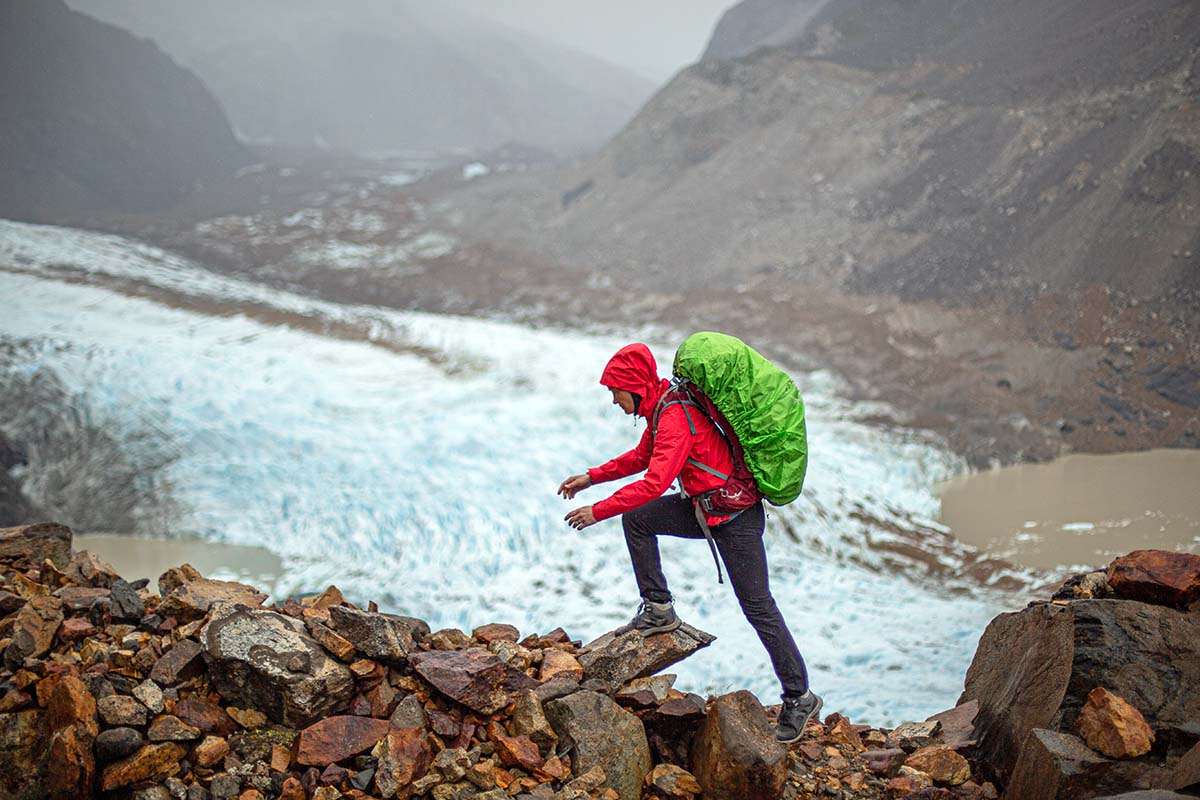
No piece of outdoor gear offers total protection from outside moisture, but a high-quality rain jacket should be able to keep out a serious squall. The most protective rain jackets (and all of our picks here) employ two main lines of defense against moisture. First is the shell fabric, which features a durable water repellent (DWR) coating that causes water to bead up and roll off rather than soaking through. Second, behind each shell is a waterproof membrane (such as Gore-Tex, BD.dry, and H2No) that is impermeable to water. Finally, some—but not all—jackets add a third next-to-skin layer for comfort, breathability, moisture wicking, and durability. As we’ll discuss below, the quality of these features will determine how well your jacket protects against rain.
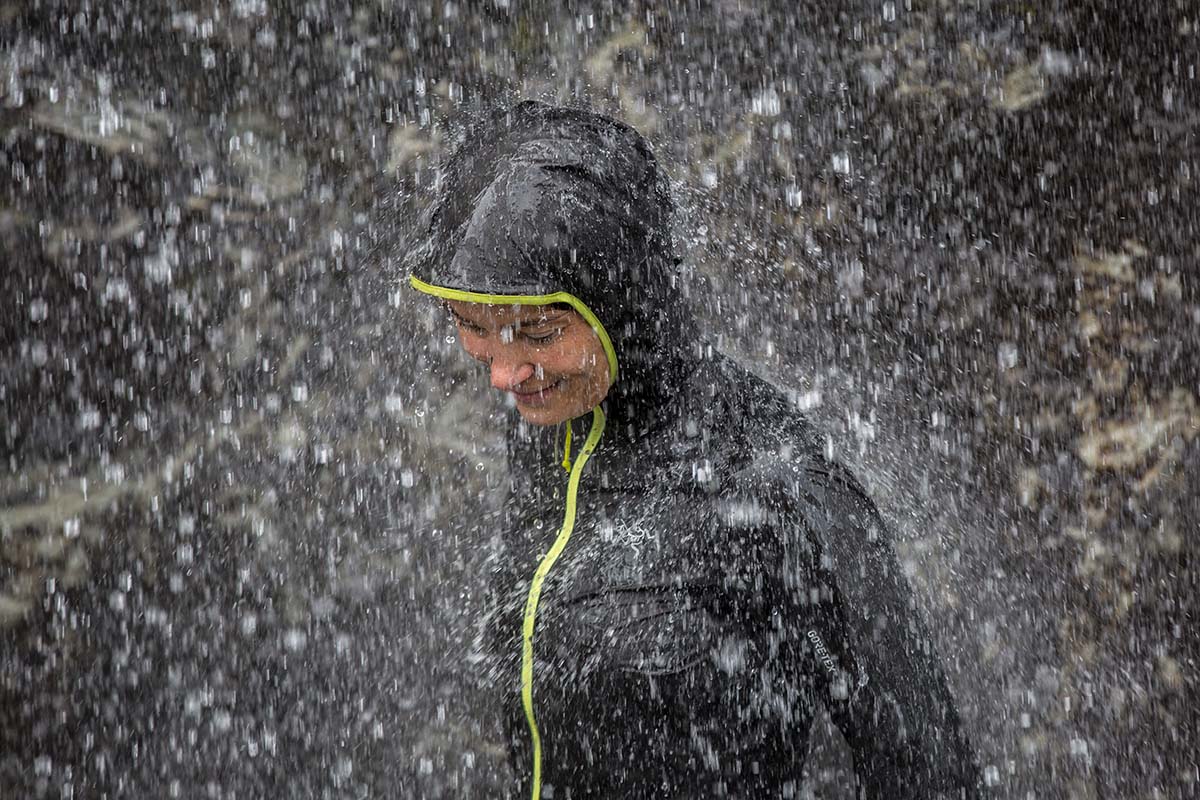
Durable Water Repellent (DWR)
The first line of defense is a rain jacket’s durable water repellent finish (commonly referred to as DWR). This coating is applied to the exterior of most rain shells to prevent moisture from absorbing into the face fabric by beading up the droplets. A fresh DWR is an impressive thing and can offer excellent protection in light to moderate conditions, although heavy and sustained rainfall will eventually overwhelm the coating (that’s where the waterproof membrane comes into play). Over time, the DWR finish will wear down, although you can keep it fresh by staying on top of maintenance (more on this in our “Care” section below).
A final note related to DWR is that there has been a recent push to move away from traditional coatings that use perfluorocarbons, which is a chemical that has been linked to environmental and health issues. It’s still a developing technology, but in 2024 most key brands have made the switch to PFC-free durable water repellent finishes. If you're interested in reading more, here's Patagonia’s breakdown.
.jpeg)
Waterproof Membrane
More than any other factor, a rain jacket’s performance in wet weather is dependent on the quality of its waterproof membrane. This is a fairly complex piece of tech, tasked with being both waterproof and breathable, along with needing to maintain a fairly streamlined build. As a result, we see a range of offerings, in terms of both performance and price. Typically, budget-oriented jackets will feature off-brand or proprietary membranes (like REI’s HydroWall and TNF's DryVent) and simple face fabrics that perform well in brief moisture but can get overwhelmed in sustained rain. On the other hand, the most premium jackets use membranes from Gore-Tex (including Paclite and Paclite Plus), which can withstand a serious squall. Technologies like Black Diamond’s BD.dry, Outdoor Research’s AscentShell, and Patagonia’s H2No Performance Standard have also held up well in our testing. The quality of seam taping is also important to a membrane’s performance, as any uncovered area could cause leaking.
.jpg)
Fabric Layers: 2L, 2.5L, 3L
In assessing a jacket’s performance in wet weather, the final factor to consider is the number of layers used in its construction. Waterproof jackets feature 2-layer, 2.5-layer, and 3-layer builds. We’ve already discussed the first two layers—a DWR-coated nylon shell backed by a waterproof/breathable laminate—which are responsible for most of the water resistance. These 2-layer jackets comprise the bulk of the rain jacket market, and range from clammy, budget-oriented models like the Columbia Arcadia II ($75) all the way up to the premium Norrøna Falketind GTX Paclite ($349). Notably, technology has improved a lot over the last few years: 2-layer designs used to be thought of as cheap and plasticky, but more modern constructions have an impressively high-end feel.
.jpg)
Stepping up to a 2.5 or 3-layer jacket doesn’t necessarily add any extra waterproofing, but it does provide an extra layer between you and the elements (similar to the theory of a double-wall vs. single-wall tent). A 2.5-layer jacket attaches a very thin coating or interior fabric to the waterproof laminate, which serves both as a protective layer (guarding the membrane from your body’s oils or abrasion from your midlayer) and can help a bit with venting, too. 3-layer designs incorporate a more substantial liner fabric, which adds a bit of bulk over a 2.5-layer, but increases durability and further improves moisture wicking and next-to-skin feel. It used to be that 3-layer construction was used almost exclusively for performance-focused hardshell jackets (think climbing and skiing), but more and more we see exceptions to this rule in the rain jacket category. For example, Patagonia’s Torrentshell is a daily use and hiking-specific rain shell with a 3-layer design. For info on the topic, see our article on rain jacket construction.
One of the most sought after features in a waterproof rain jacket is breathability: the ability for perspiration and other moisture to exit the jacket without outside water coming in. And in general, breathability improves as the price tag increases. Some of the top-performing designs from our list above include the ventilated Outdoor Research Aspire II, hardshell-like Arc'teryx Beta LT, and Rab's thin Kinetic Alpine 2.0. On the other end of the spectrum, simple 2- and 2.5-layer shells like the Columbia Arcadia, REI Co-op Rainier, and Outdoor Research's Helium Rain all run hot when you're working hard. For some, this lack of breathability is a fine tradeoff for cost savings—and pit zips can help some to offset the lack of ventilation. But if you plan to wear your shell while on the move, it's worth investing in a higher-end, breathable design.
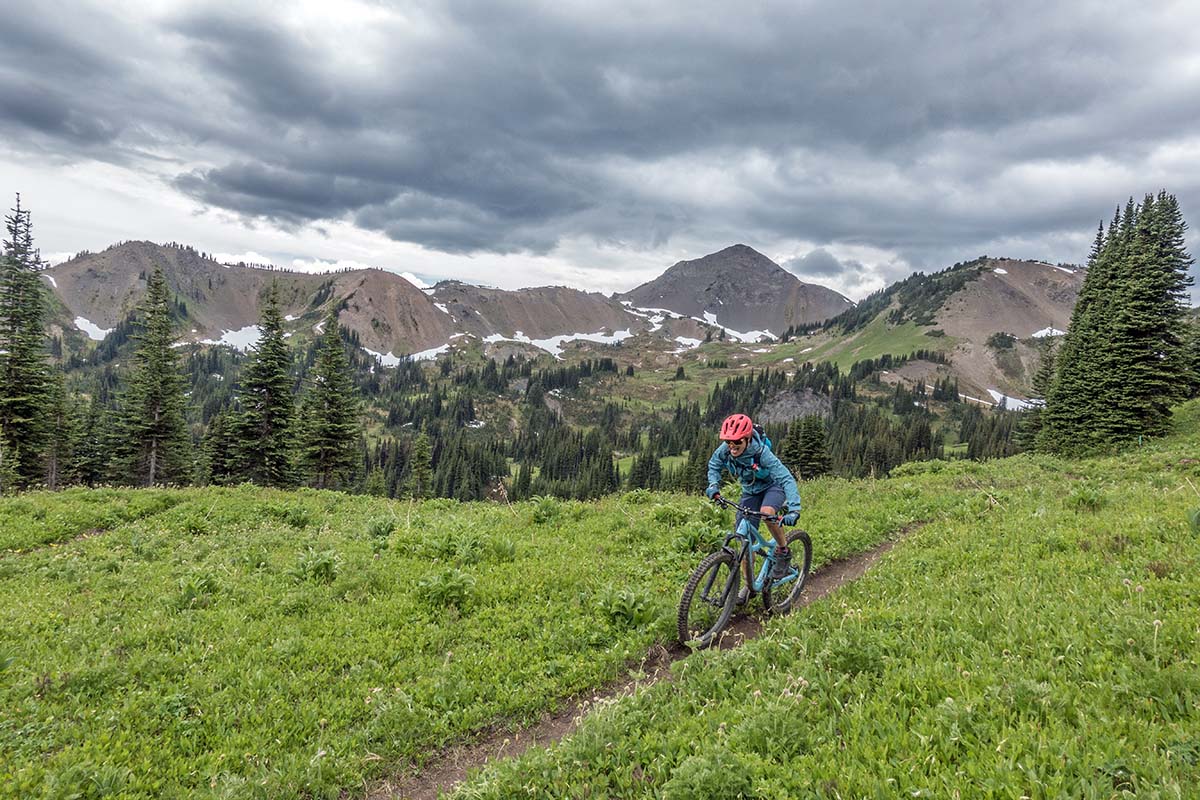
A quick look at our comparison table above reveals that rain jacket weights correlate closely with their intended use. On the lightweight end of the spectrum are performance-ready shells like the Norrøna Falketind Gore-Tex Paclite Jacket (7.8 oz.), while designs that are more feature-rich and durable for crossing over for daily wear often add a bit of weight (including the 12.4-oz. Patagonia Torrentshell 3L). At the extremes are ultralight pieces like the streamlined Outdoor Research Helium Rain, which compromises features and breathability to attain an extremely feathery 6.3-ounce weight, and everyday budget jackets like the 14-ounce Columbia Arcadia II.

A jacket’s packability can be looked at and measured in a couple ways. First, there are the jackets that stuff into their own pockets, which is great for clipping to a harness or stowing in a tight package for travel. That said, among shells that have this feature, their actual packed size can vary a lot. For example, the aforementioned OR Helium Rain's tiny stuff pocket is about the size of a few energy bars, while the bulky Columbia Arcadia resembles a small loaf of bread. The other way of looking at packable rain shells is how compressible they truly are. In that respect, the sleek Arc'teryx Beta LT would still be considered quite “packable,” despite lacking a stuff pocket: Just roll it up into its own hood to protect the thinner fabric in your pack. In the end, the weight spec is a great place to look as an indicator of how packable a jacket truly is.
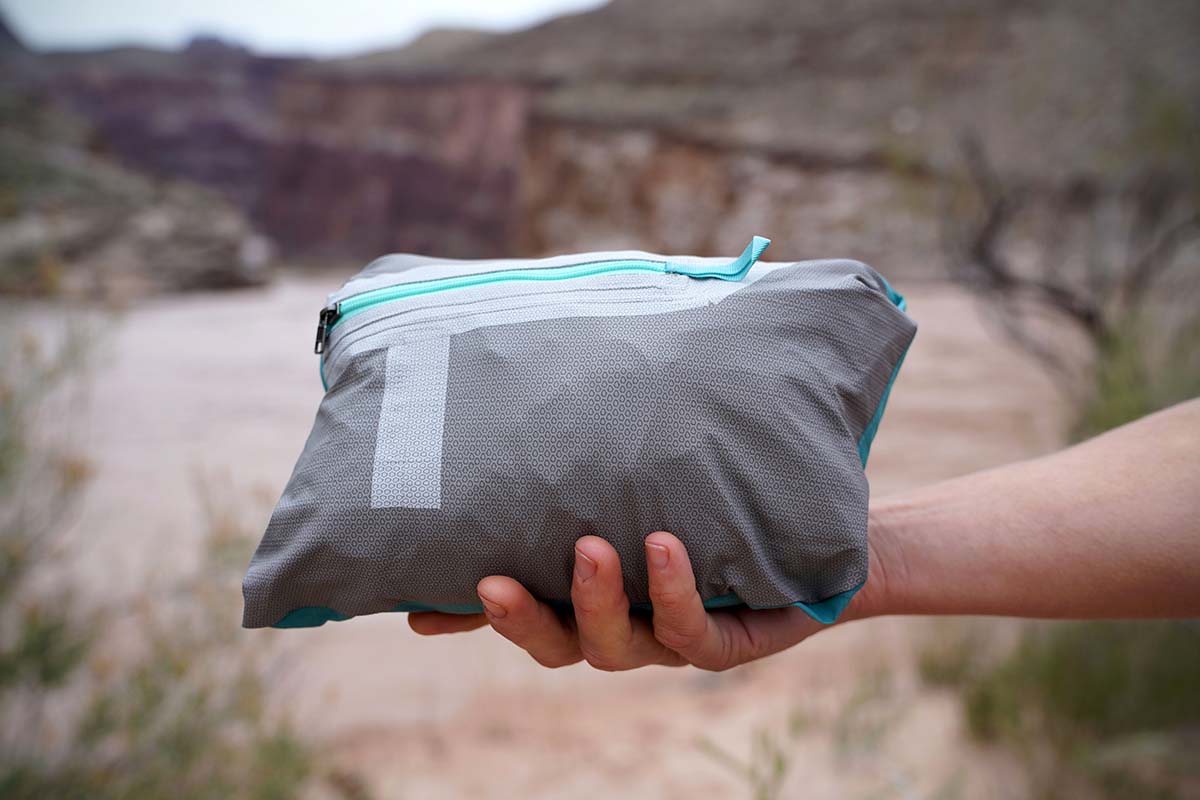
Rain jackets don’t offer as much variation in features as some other types of outdoor gear, but there are notable differences between models. Many ultralight jackets forgo pockets to cut down on weight, while other models sport them in abundance. Some rain jackets offer pit zips, core vents, or full side vents, while basic models do not. Almost all rain jackets have hoods included, and some are cut big enough to fit over a bike or climbing helmet and the style of the cinch varies significantly. Keep a close eye on features and try to match them to your intended use and budget.
Pockets
Casual users and hikers will appreciate a couple of hand pockets and a chest pocket (either on the inside or outside of the shell), which are handy whether you’re carrying a wallet around town or stashing a bar for easy access during a hike. Hand pockets are one of the most notable omissions in ultralight shells, which often opt for a single chest pocket for storage. Pocket placement is another consideration: Serious shells often place the hand pockets higher up on the torso to avoid interfering with your pack’s hipbelt or climbing harness. What you gain in convenience for outdoor performance use, you lose in daily function, especially if you like to stand with your hands in your pockets. For this reason, most of the shells in our performance category do not parlay well into daily use.
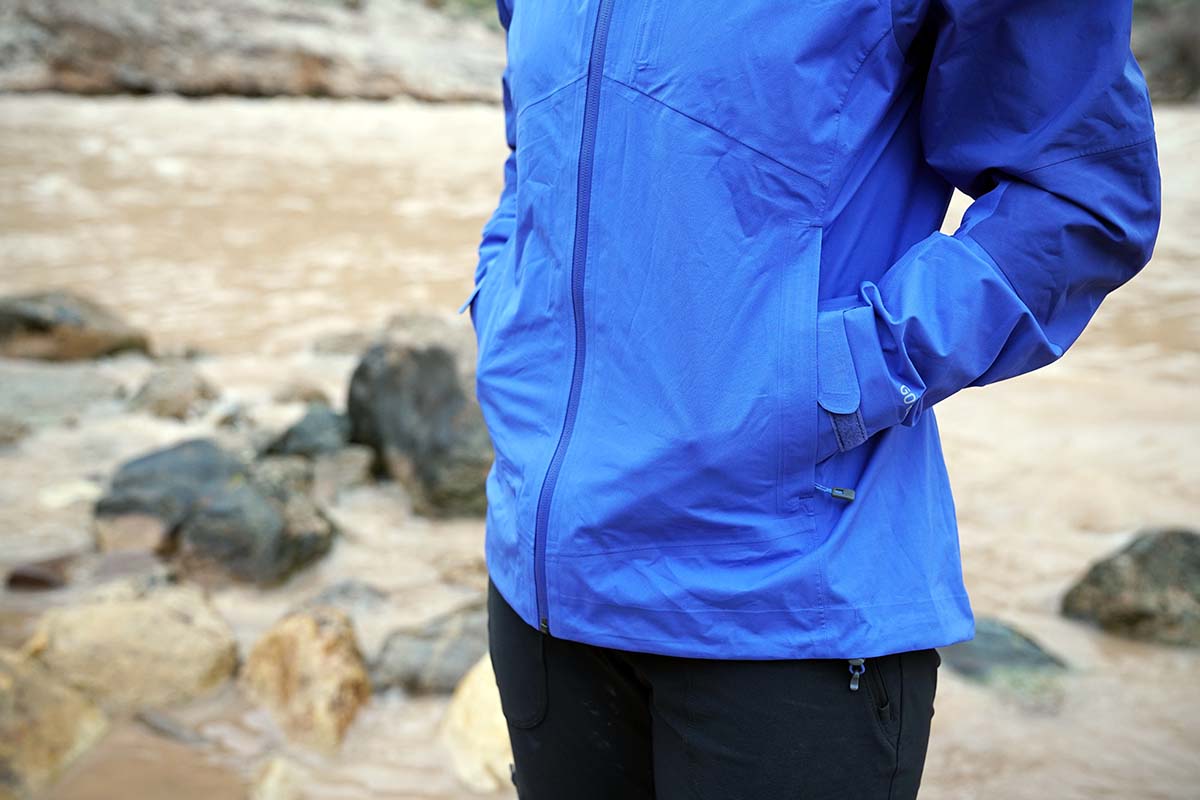
Hood
Hood size can be a big consideration when rain jacket shopping. If you plan to climb, bike, or even backcountry ski in your rain jacket, look for a helmet-compatible hood. These can reach over the top of most climbing helmets for added weather protection. For example, Norrøna's Falketind Gore-Tex Paclite is a great choice for climbers due to its large hood as well as its tiny packed size that can be easily clipped to a carabiner. For normal hiking and backpacking, it’s often prudent to avoid a helmet-compatible hood as it can be unruly, not great for visibility, and require a lot of cinching down (read: bunched fabrics).
.jpg)
Adjustability of the hood also is key. When the wind is blowing, you want a hood that conforms to your head while retaining enough structure around the sides and the bill that you can still see out. Some manufacturers succeed better than others at this concept. One standout is Arc’teryx’s StormHood: with a single pull at the back, the hood adjusts evenly around the sides and back of the head. Of the more budget-friendly options, we like the hood design of the Patagonia Torrentshell 3L, which has toggles at the back and front for quick and easy adjustments. We prefer the toggle for adjusting the back of the hood over a Velcro tab, but benefits of the Velcro style are simplicity and weight: They don’t require a cord or toggle, both of which add a bit of bulk.
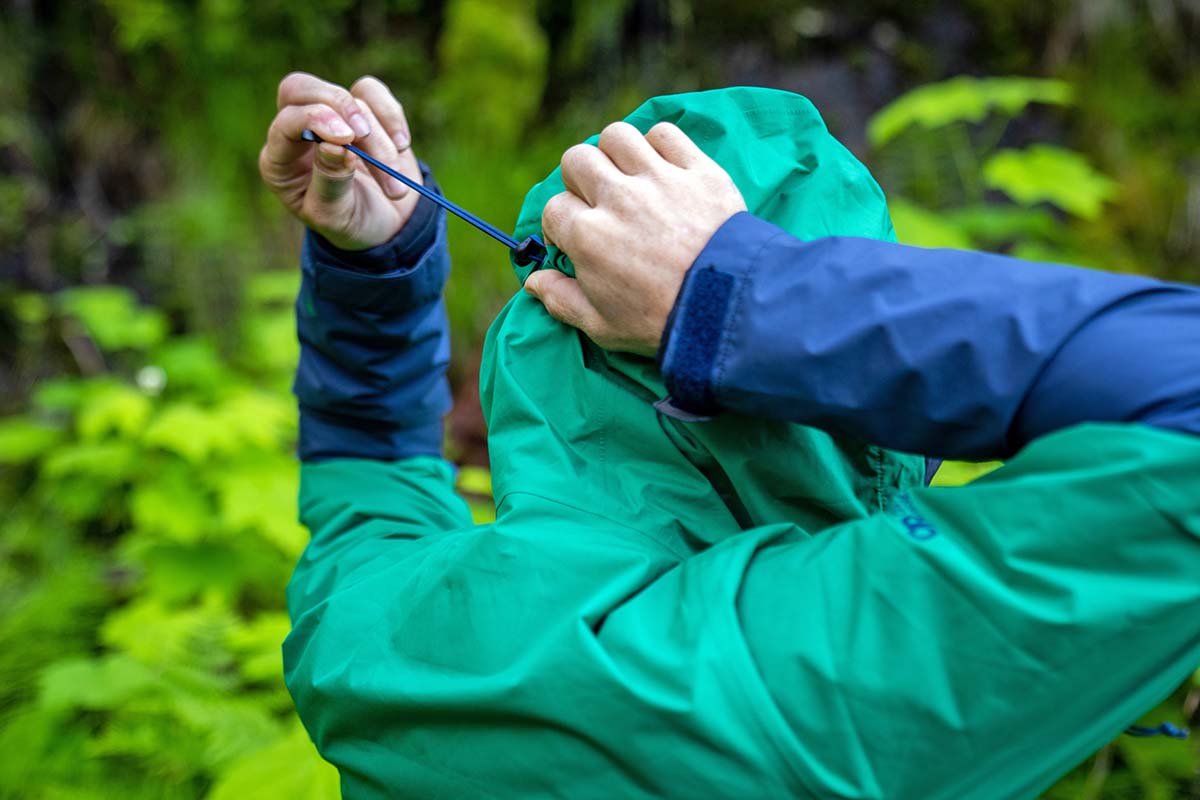
Pit Zips and Core Vents
In creating a waterproof jacket specifically designed to keep moisture out, letting air flow in the opposite direction (i.e. away from the body) can be a challenge. And when you’re working hard, it can quickly become a necessity to dump some of that hot air rather quickly. Enter the pit zip. By opening up the jacket under the arms, you can release a lot of air without sacrificing the jacket’s waterproof design. Many rain jackets include this feature, and models like Outdoor Research's Aspire II expand on it, with zips that extend all the way to the waist for exceptional ventilation.
Because adding pit zips to a jacket inevitably results in a slight weight increase, manufacturers will often omit them in ultralight jackets. But without a way for air to escape, a jacket can grow clammy in a hurry (this is our experience with ultralight models like OR's Helium Rain). REI, Marmot, and others have posed an interesting solution, pairing their hand pockets with an airy, mesh lining so they double as vents when unzipped. It’s not perfect—opening your pockets to vent means that anything stored inside could fall out—but it does save weight without sacrificing much in the way of ventilation. Other manufacturers—like Norrøna and Fjallraven—have toyed with chest vents, although we've found that unzipping the center front zip achieves the same effect.
.jpg)
Waist Adjustments
To give the best seal possible, most rain jackets that we recommend here have some sort of cinch system at the hem. Typically done with a cord and toggle, they’re very user-friendly and can be pulled tight with just one hand. Most jackets have a cinch at each hip for an even fit, but some ultralight models use just one adjustment in an effort to cut weight. The single cinch does mean that the jacket will pull to one side when tightened, but it’s often negligible and worth the weight savings.
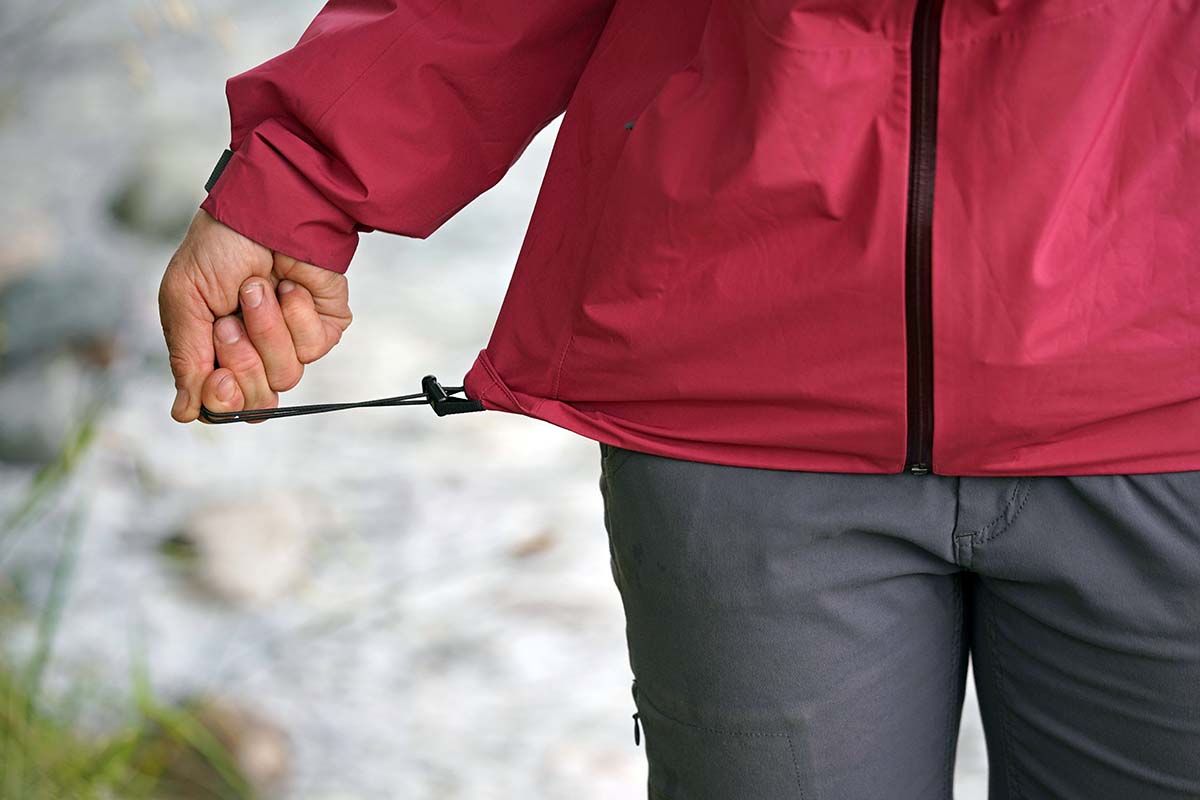
Rain jacket fit varies across the board, from roomy daily use models that allow for ample layering to svelte performance designs that place a premium on mobility and weight-savings. If you’re shopping for a rain shell to wear around town, we recommend looking for a regular fit that can accommodate bulky sweaters, scarves, blazers, and more. Parka-style jackets like the Outdoor Research Aspire Trench are also great for daily use, but fit can be tricky depending on your body shape, including where the contours land at your waist and whether or not the hem falls too far down your legs. If you can, we recommend trying on a thigh-length jacket before buying.

On the other hand, if you want to be able to move around in your jacket without excess fabric getting in the way (think activities like climbing and skiing), it’s best to opt for a trim-fitting performance jacket. Most of the time, these feature premium patterning like articulated elbows and gusseted underarms to help with freedom of movement, and their streamlined designs are great for layering over a midlayer (such as a lightweight synthetic insulated jacket), but not much more. Jackets designed for hiking generally land in between the extremes (the Patagonia Torrentshell’s sleek yet roomy fit is a great example), and as a result are some of the most versatile options here.
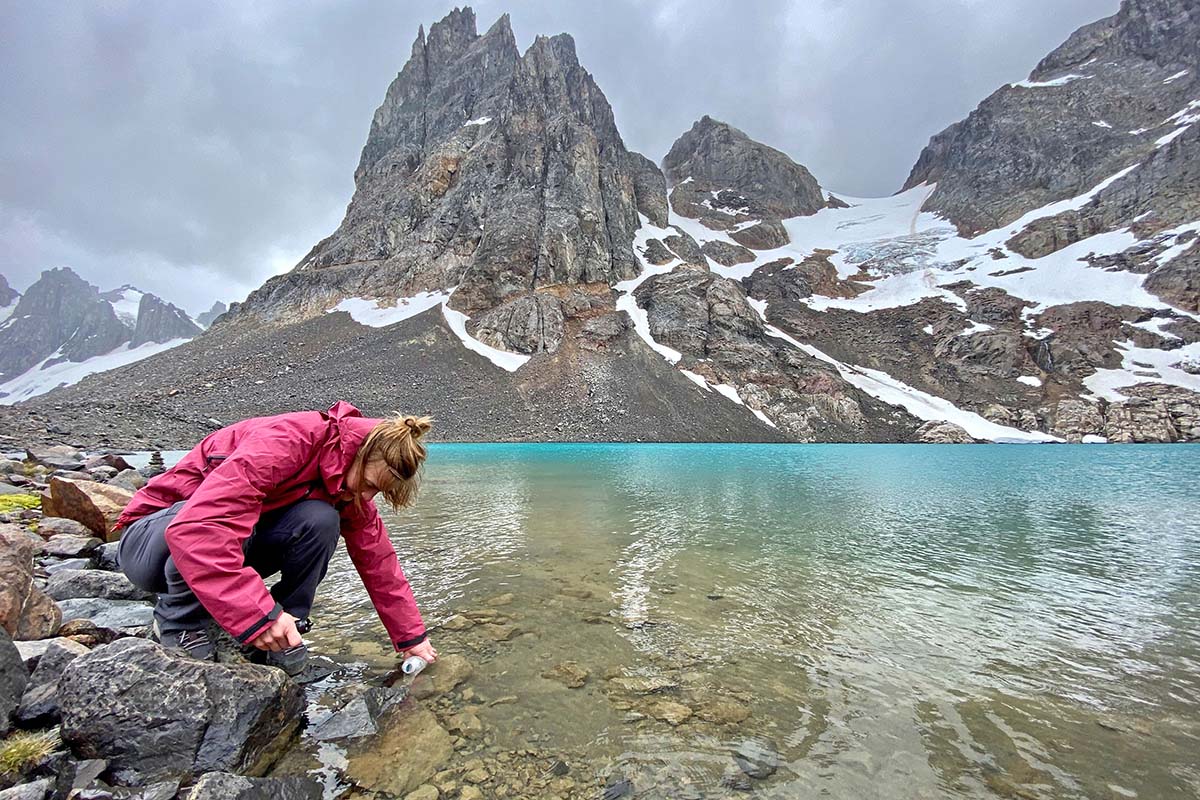
Over the past few years, there have been a growing number of waterproof rain jackets featuring built-in stretch. Designs like Black Diamond’s StormLine and Rab Kinetic Alpine 2.0 incorporate fabrics and a waterproof internal membrane that flex surprisingly easily. For performance use, the benefits are obvious: while climbing, hiking, or other activities where you’re moving your arms a lot, a stretchy jacket is less restrictive. What’s more, we’ve also enjoyed the greater level of comfort and less crinkly feel for daily wear. In general, a stretchy rain jacket will cost more than a standard shell, but it’s a nice upgrade that comes with plenty of tangible benefits.

Traditional softshell jackets are not fully waterproof. While the outer fabric typically has a DWR coating, letting light showers bead up and roll off, the seams usually aren’t taped and the fabric will eventually let water seep through. A softshell is also a bit thicker than a rain jacket, and offers a small amount of warmth as a result. Even as technologies have advanced and full waterproof softshells have become available, they still can’t compete with the waterproofing performance of a traditional rain jacket. Instead, softshells remain a better choice for those looking for a breathable, but only water-resistant (i.e. not waterproof), outer layer. Popular applications include backcountry skiing and trekking in mild weather. For a list of our top picks, check out our article on the best softshell jackets.
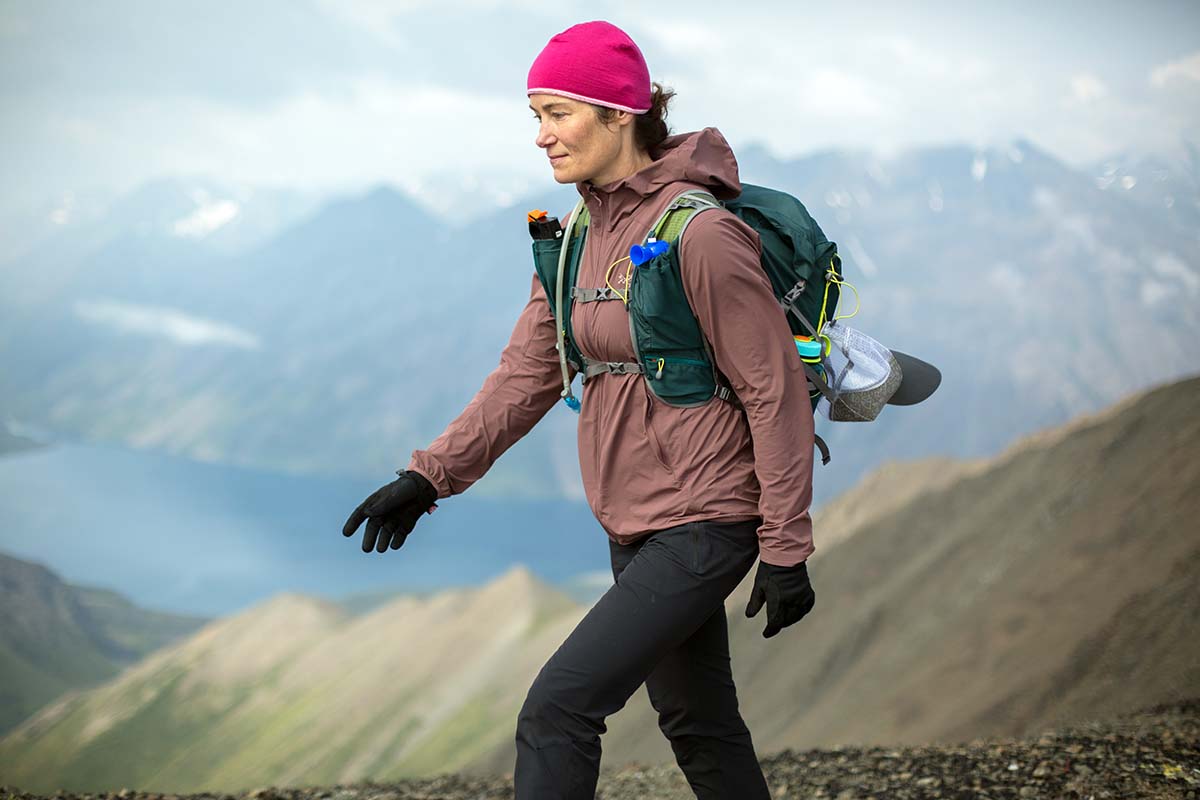
Hardshell jackets, in contrast to the rain jackets we’ve listed above, are made for truly extreme conditions. Built to withstand heavy driving rain and wind, the jackets are heavier and bulkier, and often feature more durable 3-layer construction. As a result, a hardshell is less prone to being soaked through under sustained rainfall, and is generally more breathable as well, which makes them a great choice for high-output activities like mountaineering and backcountry skiing. You’ll also see prices skyrocket for these technical pieces, thanks to their high-end detailing and premium materials. Notably, the line between hardshell and rain jacket is growing grayer by the minute—Rab’s Kinetic Alpine 2.0 is on the thin side for a hardshell (more akin to a rain jacket), while Patagonia’s Torrentshell has a hardshell-like 3L build but lacks the category’s technical feature set. For more, see our article on Hardshells vs. Rain Jackets: How to Choose.
.jpeg)
As we mentioned above, a rain jacket’s waterproofing relies on a combination of factors: the durable water repellent (DWR) coating that beads up water, the waterproof membrane, and the fabric layers on either side of the membrane. It’s important to keep all of these components clean so that they function properly, whether their job is to stop water or to let air through. This will vary based on use, but we aim for every few weeks with some of our more commonly used gear.
.jpg)
For washing, it’s always best to start by checking the label on your jacket as the specific instructions will vary. As a general recommendation, the following works well for us: wash the jacket in warm water with liquid detergent, and run it through a second rinse cycle to clear out any detergent residue. We’ll often line dry our outerwear (this helps to preserve its lifespan), until it’s almost dry, and then tumble dry it on warm for at least 20 minutes to revive the DWR finish. And of course, make sure to check your garment’s labels as this could vary based on the fabrics and technology.
If you’re noticing that the jacket isn’t beading up water anymore and putting it in the dryer for a short stretch doesn’t fix the problem, you may need to reapply some DWR (this is common as the coating diminishes over time). A waterproof jacket without DWR won’t protect or breathe as well in heavy rain because the water will pool up and soak into the exterior fabric layer. Reapplying the DWR is done through a fairly simple process, and we’ve found that the Nikwax TX.Direct Spray-On works well. Notably, some of the new PFC-free DWR finishes—like the one from Black Diamond—are ultra-durable and do not require a wash/dry cycle or reapplication in order to be revived.
Back to Our Top Women's Rain Jacket Picks Back to Our Women's Rain Jacket Comparison Table